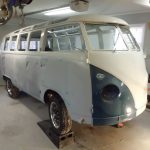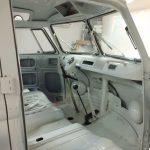I got the bus back onto its wheels and have it raised as high as it will go for the next steps. I’ve been putting this off for a while but the last remaining metal work is to the center crossmember and passenger side front ‘belly pan’. It looks really bad but it’s actually very well isolated to the crossmember and heating duct. It appears that water came into the crossmember from the drain holes above and, with it’s own drain holes clogged, the water stayed in the corssmember, rotting it. The bus structure is a uni-body design, being supported by a complex web of parts instead of body-on-frame construction; so although I wouldn’t want to drive it this way there isn’t any danger of the entire bus becoming warped due to having this piece (temporarily) missing. My next step is to cut this crossmember out and weld in the new one. While everything is setup for easy underside access I’ll also POR15 the entire underside to stop the surface rust.
I also connected the parking brake, clutch, and shifter linkages; these will need some tweaking and a few small parts but are generally working for the first time since I’ve had it. The next action in this category is to get the hydraulic brakes working; this will mainly consist of replacing all of the steel brake lines, making the connections, and bleeding the brakes.
As for the title of this post, look closely at picture #1 “Made in W. Germany”; in 1967 Germany was still 23 years away from reunification.






